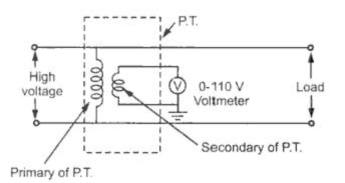 |
| Fig. 1 Potential transformer |
As a normal transformer, its ratio can be specified as,
V1/V2 = N1/N2
So if voltage ratio of P.T. is known and the voltmeter reading is
known the the high voltage to be measured, can be determined.
Example : A 11000 : 110, potential transformer is used along with a voltmeter reading 87.5 V. Estimate the value of line voltage.
Solution : For a P.T. V1/V2 = 11000/110
and V2 = 87.5 V
... V1/87.5 = 11000/110
... V1 = 8750 V
This is the value of high voltage to be measured.
1.1 Construction
The potential transformer use large core and conductor sizes
compared to conventional power transformer. In potential transformer,
economy of material is not a important consideration at the time of
design. The accuracy is an important consideration.
The shell type or core type construction is preferred for
potential transformer. The shell type is used for low voltage while core
type for high voltage transformers. At the time of assembly special
core is required to reduce the effect of air gap at the joints.
The coaxial primary and secondary windings are used, to reduce
the leakage reactance. ye secondary winding which is a low voltage
winding is always next to the core. The primary winding is a single coil
in low voltage transformers. For high voltages, insulation is the main
problem. Hence in high voltage potential transformers, primary is
divided into number of small sections of short coils to reduce the need
of insulation between coil layers.
The cotton type and varnished cambric are used as the insulations
for windings. Hard fiber separators are used in between the coils. The
oil immersed potential transformers are used for the voltages levels
above 7 kV. For oil filled potential transformers, oil filled bushings
are used. Two bushings are required when no side of the line is at earth
potential.
The overall construction of single phase, two windings potential transformer is known in the Fig. 2.
 |
| Fig. 2 Single phase potential transformer |





Thank you for sharing such useful information with us. keep sharing.
ReplyDeleteInductor Coil Manufacturer in India | Medical Isolation Transformer in India
potential transformer
ReplyDelete